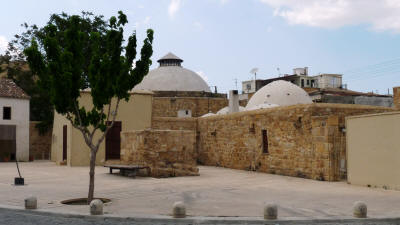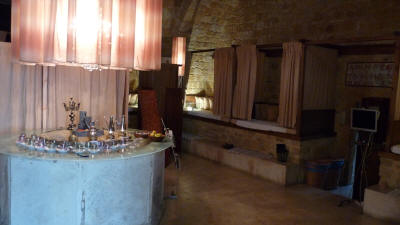The Omeriye Hamam (Turkish Baths)
Nicosia, South Cyprus
 |
| The Omeriye Turkish Baths |
The Omeriye Ottoman Baths is a late 16th century stone structure located just north of the Omeriye Mosque. It was built by Lala Mustafa Pasha as a gift to the city, following the Ottoman conquest of Nicosia in 1570-71. One of only two remaining intact Turkish baths in walled Nicosia, it is the only one operational till the renovations of the Buyuk Hamam in the northern part of the city are completed.
The first hamam, meaning communal bathhouse appeared in Syria, though the Romans and Byzantines had a similar way of bathing. It was initially used by Moslems because it was considered to be a cleansing process. When the Turks reached Anatolia, they liked this way of bathing, and introduced it to the entire Ottoman empire. They combined the different traditional methods of bathing, creating a new way of bathing, which is known worldwide as Turkish baths.
The Omeriye Bath is a stone structure, built from local materials. The domes and stone walls make it a significant landmark in this part of the city.
The building has north and south entrances. The south entrance is reached through a small courtyard. The baths are a typical example of Ottoman baths of the time and consist of three areas: the entrance hall, which is used mainly as a changing room, an intermediate warm room , and the main hot bath area.
 |
| The Entrance Hall |
You enter the hamam into the entrance hall, a large square room with a dome and cupola at its peak. This is where you undress and get ready to go into the warm chamber. This domed area has a small octagonal pool in its centre, and curtained divans for privacy when undressing and resting at the completion of bathing.
From here you move to the warm chamber, which has three main spaces covered by domes and pointed vaults. The main use of this room is to prepare your body ready for the hot chamber. Traditionally, this chamber was also used for activities such as shaving and cutting hair.
The hot chamber is the main part of your visit to the hamam. It is a square room, again domed, with smaller chambers leading off, each with hot and cold running water. In the centre of the chamber is a stone bench, used for massages. The chamber is heated with under floor heating to around 26 degrees, and the system also produces steam for the hot room. (You can see an example of this under floor heating system in the remains of the Kertikli Hamam if you visit Famagusta)
Having bathed, you then follow the same sequence of events in reverse, ending up in the cool chamber with an opportunity to rest on the divans.
All this should take around two hours, and costs €20. Additional treatments are available at extra charge. The hamam is open daily, but is segregated. Mondays are for couples only. Tuesdays, Thursdays and Saturdays are for men, with the remaining days for women.
The restoration of the Omeriye baths was done as part of the Nicosia Master Plan. The work carried out on the bath complex included structural repairs to the walls and roof domes, waterproofing, complete reconstruction of the suspended floors, repairs to the external stone walls and internal finishes, ceilings, paving and fittings, as well as the replacement/restoration of the old steam system.
See the location in Google maps
Back to South Nicosia Index